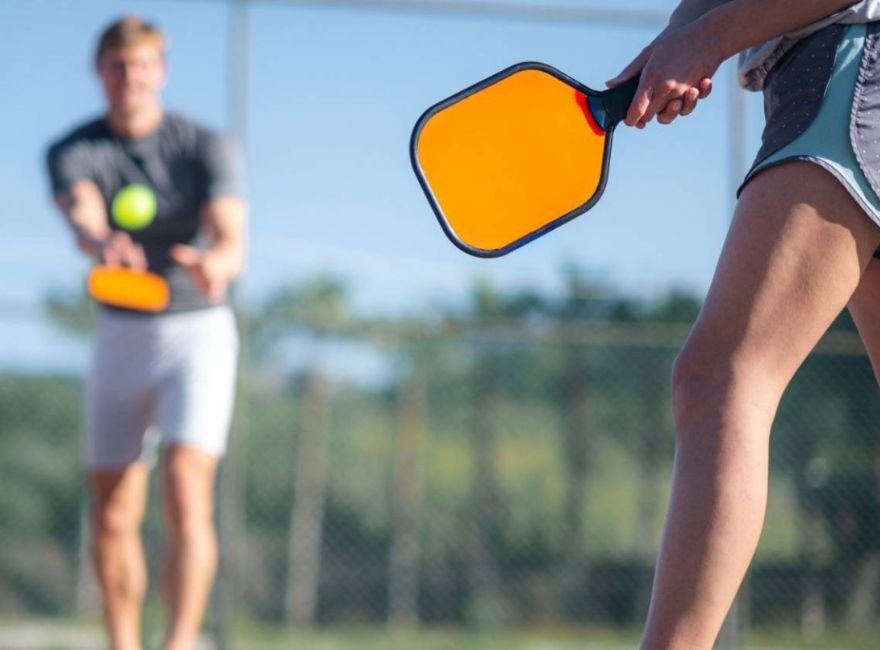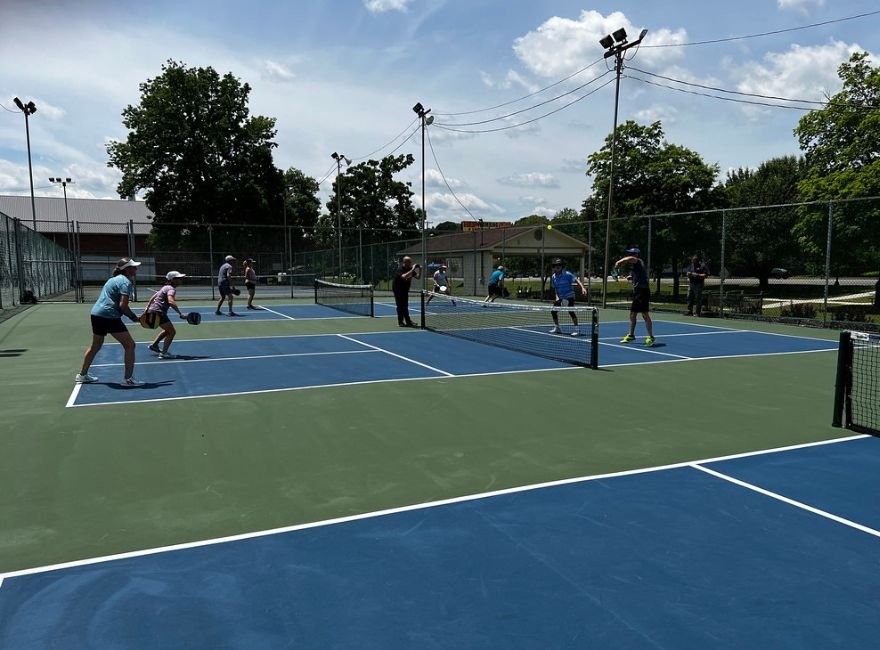Where to stand in pickleball

Even seemingly simple things like deciding where to stand in pickleball can have a big impact on how well you play. Here’s what I’ve figured out about where to position yourself and how it has helped me improve my game more quickly.
In pickleball, where you stand on the court is super important. It’s like picking the right spot to catch a ball. Let me break it down for you. If your opponents like hitting the ball far away, stand behind the baseline. It gives you room to let the ball bounce, which is a rule. This is a safe spot.
But if they prefer short shots, stand just in front of the baseline. It helps you get closer to the ball quickly without risking much.
Get a deep dive into “Rules, Ratings, And Techniques” by reading our thoughtfully crafted blog post.
Some really good players stand off to the side. They do this when they have a plan called “stacking.” One player serves from the middle, and the other waits at the sideline. They switch places after the third shot.
So, most players pick one of these three spots:
- Slightly in front of the baseline
- On the baseline
- Behind the baseline
But that is not enough, let’s go deeper and understand the topic.
Position in Pickleball

Serving
Let’s kick things off with the serving team. Wondering where you should stand when you’re serving? First, find a smart spot diagonally across the court that lets your serve land beyond the kitchen line and within the boundaries. You can set up anywhere in your serving quadrant, as long as it’s behind your baseline and not in your partner’s area. You’ve got some flexibility – it could be in the middle, leaning towards the left or right corners.
Most players, including myself, usually go for a spot somewhere in the middle without hugging the corners too tightly. Rarely do you see top-notch players sticking too closely to one corner when serving. Now, let’s talk about how close to the baseline you should be. Well, that’s a matter of personal preference.
On the flip side, if I’m too close, I risk stepping over the baseline, resulting in a foot fault, and I haven’t given my team a fair shot at scoring. That’s a simple mistake that’s best avoided.
Tip: When serving, it’s not a good idea to stand with both feet parallel and shoulder-width apart. Instead, your dominant foot (the same side as your serving hand) should be positioned behind, and your other foot should be up at the baseline in a comfortable spot.
Server’s Partner
When you’re the partner of the server, figuring out where to stand can be a bit of a puzzle. But let’s make it simple. You’ll be hanging out on the same side of the court as the server, right along the baseline. However, unlike the server, you have a bit more freedom with your feet. You can plant them on the baseline itself, or if you prefer, just a tad in front of it.
Technically, you have some wiggle room, but here’s the deal – it’s a smart move to stay towards the back. Why? Well, there’s this two-bounce rule, and it’s important for that rule to play out. You can learn more about it if you want.
As the server’s partner, don’t be too hasty to inch forward. Keep an eye on how the opposing team returns the shots. If they tend to send the ball deep into the court, you should hang back with your partner, not venturing too close to the net. But, if the opposing team’s returns aren’t going that deep, you can move a bit closer. You can keep your feet on the baseline or maybe step a bit forward if it feels comfortable. However, be cautious. If your partner serves, and you’re too close to the “kitchen line,” you become an easy target for the return team. You see, you need to leave some space for the ball to bounce after the serve.
If a speedy shot comes your way, and you don’t allow room for it to bounce, you’re caught off guard and give your opponents an advantage. Remember, we want to minimize those avoidable mistakes. Regardless of where you stand, make sure to keep enough space to move forward when attacking a return shot. It’s much easier to step into a shot than to scramble backward for it.
Tip: If you find yourself retreating to get to a return shot, you’ve probably ventured too far forward. Give yourself some space to move back and set up for a charged, forward-moving shot.
Returning
Let’s talk about where to stand in pickleball when you’re on the return team. When you’re facing the server, you should be about one to two feet behind the baseline. This gives you space to handle shallow hits and also be prepared for deep serves.
Now, when it’s your turn to return the serve, you might want to set up for your forehand shot and avoid relying on your backhand, which might not be as reliable. To achieve this, simply position yourself to the left or right, depending on where the serve is coming from. How far back should you stand as a returner? Well, the serving team will likely aim for the baseline you’re near, so give yourself some room to adjust without needing to move backward while you hit the ball. Remember, hitting accurately when you’re moving backward is much harder and makes you an easy target for your opponents.
Tip: Stand with your feet shoulder-width apart, knees slightly bent, on the balls of your feet, and hold your paddle firmly in your dominant hand in the middle of your body. This is the ideal “pickleball ready” position. I also like to keep my other hand softly on the paddle handle for a versatile grip suitable for any type of hit.
On the Return Team
So, if you’re part of the return team but not the one receiving the serve, where’s the best spot to stand? Well, the most common place for you to stand as the return team’s partner is right up at the no-volley zone.
Keep in mind that as a member of the return team, your main job is to let the serve bounce. That’s the only time the ball needs to touch your side of the net. This means the return team can move towards the net faster. If you’re on the return team but not receiving the serve, it’s a good idea to be in the ready position, which is at the kitchen line.
Tip: You’ll be the first one on the net, so make the most of this advantage. Be prepared to take advantage of any weak third shot that comes your way.
For the Third Shot
Let’s talk about what to do when you’re on the serving team and you’re about to return the shot from the other team, which is commonly referred to as the “third shot”. So, when you’re in the position to make the third shot in pickleball, where should you stand? Well, you and your partner should remain near the baseline because the ball needs to bounce before you hit it.
This rule applies even when you’re playing singles. You should stay close to the baseline and be prepared for a deep shot from your opponent. But exactly where on the baseline should you stand? Your positioning should resemble that of the return team when they serve. You’ll want to be near the baseline, give or take a few feet.
Once again, make sure you have some extra space and stay at the baseline. I personally prefer to stand directly on the baseline or even take a step or two forward. Most of the time, return shots after the serve are deep, but they’re usually not as deep as the serve itself. So, anticipate the ball landing in front of the baseline but ensure you have some room to adjust.
Tip: Standing near the baseline, on the balls of your feet, with your shoulders about hip-width apart, ready to move side to side, is the best position to be in. This way, you’ll be in the optimal spot to execute that critical third shot drop.
When Dinking
In doubles play, it’s pretty straightforward. You and your partner should position yourselves right at the kitchen line, at the center of your side of the court. This way, you’ll be all set to defend against drop shots from any direction. But don’t forget to be prepared for those trendy “drive shots” aimed at you. They come at you fast and furious.
Now, for your positioning at the kitchen line and your footwork. Keep your weight on the balls of your feet, and stand with your feet shoulder-width apart.
Tip: Be ready to step into the no-volley zone when the ball bounces there. If the ball goes to your left, take a step with your right foot and pivot on your left foot. If the ball heads to your right, step with your left foot and pivot on your right foot.
Let’s sum it all up.
There aren’t strict rules about where to position yourself in pickleball, except that the serving player should be behind the baseline when serving.
Positioning can get a bit tricky, and it might change depending on your team’s score. Most matches offer flexibility in this regard. The key goal is to ensure that you and your partner are in the best possible position to start each round and move around easily as the game unfolds.
Mastering these subtle aspects of positioning in pickleball can significantly enhance your gameplay, and ultimately, it adds more fun to your pickleball experience.
Finally, let’s have a quicker look at the most frequently asked questions.
Where is the best place to stand in pickleball?
The best place to stand in pickleball depends on the situation. In general, two common positions are the baseline and the no-volley zone (kitchen line). It’s essential to be in the right position to start each round and adapt as the game progresses.
Where do you stand on serve in doubles pickleball?
In doubles pickleball, you stand at the baseline when serving. Both players remain behind the baseline until the first two shots have bounced. After that, they can advance to the net.
What is the starting position in pickleball?
The starting position in pickleball typically involves both players on the serving team standing at the baseline. The receiving team’s players are positioned on the other side of the net, with one player at the baseline and one player at the net.
Do you have to stay on your side in pickleball?
In pickleball, you must stay on your side of the court during the game. Players are not allowed to cross over the centerline, except after the ball has bounced and crossed the net.
